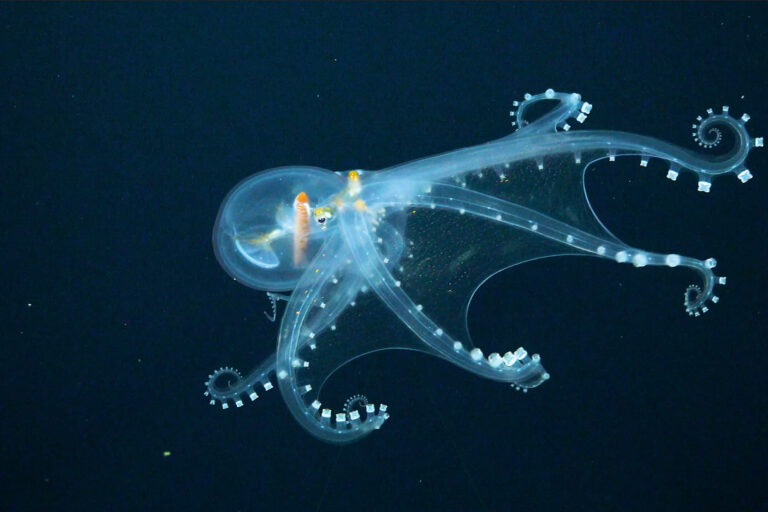- A team of international scientists on board the RV Falkor (too), a research vessel operated by the Schmidt Ocean Institute, recently discovered active hydrothermal vents on the Mid-Atlantic Ridge.
- This discovery was the first in more than 40 years for a 700-kilometer (423-mile) stretch of the Mid-Atlantic Ridge.
- Researchers say hydrothermal vents help regulate global ocean chemistry, support complex ecosystems, and store vast amounts of marine genetic resources.
- However, there is already interest in mining the sulfide deposits of hydrothermal vent systems for their commercially valuable minerals.
On March 12, a team of scientists gathered in the control room of the RV Falkor (too), an oceanographic research vessel operated by the Schmidt Ocean Institute. They watched the monitor of a camera-wielding underwater drone, or ROV, as it explored the deep sea 2,000 meters (6,600 feet) below the ship. When the screen showed a plume of black smoke, the scientists cheered.
The video showed a sprawling field of hydrothermal vents — fissures in the seabed where seawater mixes with magma — on the Puy des Folles Volcano on the Mid-Atlantic Ridge. Some of the vents, known as “black smokers,” had formed tall “chimneys” of iron sulfide deposits that gushed out dark, sulfurous plumes with temperatures up to about 340° Celsius (644° Fahrenheit), hot enough to melt lead. Despite the sizzling water, the vents swarmed with shrimp and other deep-sea life perfectly adapted to this environment.
Previous expeditions to this part of the Mid-Atlantic Ridge, an underwater mountain range that marks the boundary between two tectonic plates, have failed to find hydrothermal vents. But a team of international scientists from 11 research institutions managed to find them — for the first time in more than 40 years in 700-kilometer (423-mile) stretch of the Mid-Atlantic Ridge — by employing a new strategy.
They first created a “seafloor roadmap” using the RV Falkor (too)’s multibeam sonar. Then they used instruments to find traces of hydrothermal activity in the seawater, such as changes in temperature and the particle content of the water, as well as chemical changes, such as fluctuations in hydrogen, methane, or hydrogen sulfide. The scientists also created a high-resolution map that showed “seafloor features as small as a coffee table” and enabled them to identify hydrothermal vent structures.
“The ability to carry out multi-vehicle operations aboard the Falkor (too) enabled an incredibly fast pace of seafloor exploration,” Julie Huber, a senior scientist at Woods Hole Oceanographic Institution (WHOI), told Mongabay in an email. “I was amazed at how quickly we went from a blurry map to a high-resolution map with chemical hints of venting to finding a gushing black smoker over two miles deep. The talented team of geologists, engineers, chemists, and biologists worked incredibly hard to keep up this rapid pace of discovery.”
David Butterfield, an ocean chemistry expert at the University of Washington and the NOAA Pacific Marine Environmental Lab in Seattle, said that while the team anticipated finding black smokers at the Puy des Folles Volcano, they didn’t expect to find them at two other sites: the Grappe Deux vent system and Kane Fracture Zone. However, he said the team’s strategy led them to success.
“We had the right tools, the right strategy, and enough time to systematically search,” Butterfield told Mongabay in an email. “Everything worked well, and the weather cooperated.”
Hydrothermal vents like these are of particular interest to scientists because of their critical role in regulating global ocean chemistry by transporting heat and chemicals from the interior of the Earth. Researchers say these systems also support complex ecosystems for vent-dependent organisms like shrimp, crabs, mussels, anemones, fish and gastropods, and store vast amounts of marine genetic resources.
While there is still much to learn about hydrothermal vents, there is already interest in mining the sulfide deposits of hydrothermal vent systems for their commercially valuable minerals. For instance, the International Seabed Authority (ISA), the U.N.-appointed body tasked with regulating future deep-sea mining activity in international waters, has previously issued three exploration licenses to Russia, Poland and France to survey hydrothermal mineral deposits along the Mid-Atlantic Ridge.
However, scientists say that such plans should be approached with caution. A 2018 study from Marine Policy argued that active vents should be off-limits to deep-sea mining because of their vulnerability and the limited amount of mineral resources they would actually supply.
Dawn Wright, a deep-sea biologist and chief scientist of California-based mapping outfit Esri, who was not on the expedition, said the work being conducted on Falkor (too) is vitally important to understand the deep ocean and the potential impacts of future activities like deep-sea mining.
“The discovery, not only of additional active venting sites, but the shocking abundance of life at these sites, should now, thankfully, exclude these sites from consideration for mining,” Wright told Mongabay in an email. “There is still so very, very much more that we need to learn about how these ecosystems function, how nutrients are cycled among and within the vent animals, and the sheer biodiversity of these animals.
“With new species consistently being discovered, there may even be a cure for cancer or COVID in these places,” Wright added. “And we need to understand much more about the role that the vents play as a sink for carbon and methane, two of the most troublesome greenhouse gases.”
Banner image: A glass octopus, a nearly transparent species whose only visible features are its optic nerve, eyeballs and digestive tract, sighted during the expedition. Image by Schmidt Ocean Institute (CC BY-NC-SA 4.0).
Elizabeth Claire Alberts is a senior staff writer for Mongabay. Follow her on Twitter @ECAlberts.
Related reading: ‘Antithetical to science’: When deep-sea research meets mining interests
Citation:
Van Dover, C. L, Arnaud-Haond, S., Gianni, M., Helmreich, S., Huber, J. A., Jaeckel, A. L., … Yamamoto, H. (2018). Scientific rationale and international obligations for protection of active hydrothermal vent ecosystems from deep-sea mining. Marine Policy, 90, 20-28. doi: 10.1016/j.marpol.2018.01.020
This story first appeared on Mongabay
South Africa Today – Environment
This article is licensed under a Creative Commons Attribution-NoDerivatives 4.0 International License.
You may republish this article, so long as you credit the authors and Mongabay, and do not change the text. Please include a link back to the original article.












